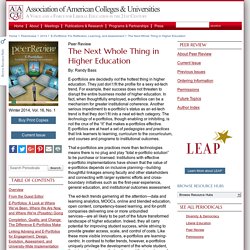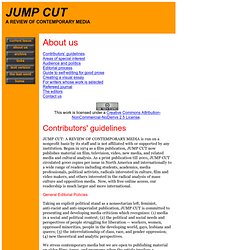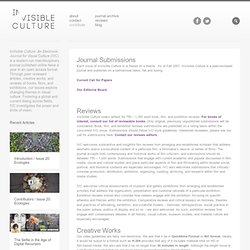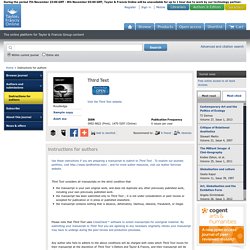

The Next Whole Thing in Higher Education. E-portfolios are decidedly not the hottest thing in higher education.

They just don’t fit the profile for a sexy ed-tech trend. For example, their success does not threaten to disrupt the entire business model of higher education. In fact, when thoughtfully employed, e-portfolios can be a mechanism for greater institutional coherence. Another serious impediment to e-portfolio’s status as an ed-tech trend is that they don’t fit into a neat ed-tech category. The technology of e-portfolios, though enabling or inhibiting, is not the crux of the “it” that makes e-portfolios effective.
That e-portfolios are practices more than technologies means there is no plug and play “total e-portfolio solution” to be purchase or licensed. I don’t mean this conservatively or regressively. E-portfolios provide a mechanism for integrative learning; they give students a way to make connections across courses and experiences in order to create a whole greater than the sum of the curricular parts. Submit. FIELD is seeking completed essays, interviews, reviews and case studies as well as essay proposals.

We’re especially interested in the independent critique of socially engaged art that combines detailed description of a given project (based on direct observation of actual working processes) with a developed analysis and evaluation/ reflection. We are also seeking writing that develops new analytic criteria and research methodologies for the analysis of socially engaged art. Theoretical materials, when used, should be directly germane to the project under discussion and subject to some reciprocal testing, in which theoretical precepts are challenged or enriched by their engagement with practice. We invite contributions from artists, art historians, critics, curators, theorists, and activists, as well as scholars working across the humanities and social sciences (sociology, ethnography, philosophy, urban studies, geography, political science, etc.).
What to Submit How to Submit. Editorial Board and Policies. About us Contributors’ guidelines Areas of special interest Audience and politics Editorial process Guide to self-editing for good prose Creating a visual essay For writers whose work is selected Refereed journal The editors Contact us This work is licensed under a Creative Commons Attribution-NonCommercial-NoDerivs 2.5 License.

Contributors' guidelines JUMP CUT: A REVIEW OF CONTEMPORARY MEDIA is run on a nonprofit basis by its staff and is not affiliated with or supported by any institution. Visual Studies Workshop. Is a journal of media arts focusing on coverage of modern photography, artists’ books, independent film and video production, and other forms of time-based media offered from an international perspective. provides fresh critical insights that advance understanding of the media arts and how they affect wider artistic practices as well as contemporary cultural and social experience.
Exists in a niche between the mainstream art press and academic journals, providing content that is both scholarly and accessible and is of interest to a wide range of readers including artists, curators, academics, researchers, students and the general arts reader. We strive to address current issues in the international media arts world in our bimonthly print edition, elements that are reflected by and complemented on our vibrant web site. Afterimage Online Subscribe Advertise Back issues.
Invisibleculture. Journal Submissions Each issue of InVisible Culture is is based on a theme.

As of Fall 2007, InVisible Culture is a peer-reviewed journal and publishes on a semiannual basis, fall and spring. Current Call for Papers Our Editorial Board Reviews. Journal of Visual Culture1470-4129, 1741-2994. "There is an unmistakable seriousness as well as a handsome hospitality in the range of method and morality, topic and topography on show.

" Times Higher Education Supplement The past two decades have witnessed an explosion of interest, research and writing on visual culture within the humanities and social sciences. World Art - Instructions for authors. This journal uses ScholarOne Manuscripts (previously Manuscript Central) to peer review manuscript submissions.

Please read the guide for ScholarOne authors before making a submission. Complete guidelines for preparing and submitting your manuscript to this journal are provided below. Two issues of World Art are published each year. All contributions are peer reviewed, under consultation with the journal’s Advisory Board. Some volumes are guest edited and, where appropriate, contributions will be grouped by theme (please see the Call for Papers for further suggestions about appropriate themes).
The editors seek original material with intellectual integrity. The preferred language of the journal is English, but contributions in other languages will be considered. Publication includes online and print versions. Studies We look for original and creative contributions to world art studies. Third Text - Instructions for authors. Any author who fails to adhere to the above conditions will be charged with costs which Third Text incurs for their manuscript at the discretion of Third Text ’s Editors and Taylor & Francis, and their manuscript will be rejected.

This journal is compliant with the Research Councils UK OA policy. Please see the licence options and embargo periods here . Manuscript preparation Manuscript submission Copyright and authors’ rights Accepted Manuscripts Online (AMO) Free article access. Parallax - Aims & scope. 2011 Impact Factor: 0.061 Ranking: 34/35 in Cultural Studies © 2012 Thomson Reuters, 2011 Journal Citation Reports® Founded in 1995, parallax has established an international reputation for bringing together outstanding new work in cultural studies, critical theory and philosophy. parallax publishes themed issues that aim to provoke exploratory, interdisciplinary thinking and response.

Each issue of parallax provides a forum for a wide spectrum of perspectives on a topical question or concern. parallax will be of interest to those working in cultural studies, critical theory, cultural history, philosophy, gender studies, queer theory, post-colonial theory, English and comparative literature, aesthetics, art history and visual cultures. parallax regularly publishes issues compiled by guest-editors. Potential guest-editors should make an initial proposal to the editors including a title, thematic outline and suggested contributors.
Disclaimer. Early Popular Visual Culture - Instructions for authors. This journal uses ScholarOne Manuscripts (previously Manuscript Central) to peer review manuscript submissions.

Please read the guide for ScholarOne authors before making a submission. Complete guidelines for preparing and submitting your manuscript to this journal are provided below. Use these instructions if you are preparing a manuscript to submit to Early Popular Visual Culture . Visual Studies - Instructions for authors. This journal uses ScholarOne Manuscripts (previously Manuscript Central) to peer review manuscript submissions.

Please read the guide for ScholarOne authors before making a submission. Complete guidelines for preparing and submitting your manuscript to this journal are provided below. Use these instructions if you are preparing a manuscript to submit to Visual Studies . History of Photography - Instructions for authors. Instructions for Authors Use these instructions if you are preparing a manuscript to submit to History of Photography . To explore our journals portfolio, visit , and for more author resources, visit our Author Services website. History of Photography considers all manuscripts on the strict condition that. Information for Authors. For general guidance see The Oxford Guide to Style (Oxford, 2002) and the Oxford Dictionary for Writers and Editors (Oxford, latest edn). The Oxford Art Journal normally publishes articles between 8,000 and 9,000 words in length (including footnotes/endnotes). When submitting a paper please provide a word count for both the main text and the notes separately.
Please also provide an abstract of between 150 and 200 words. All text should be double spaced (including footnotes and captions). Unaccepted manuscripts will not be returned to authors. Editorial Board — Historical Materialism Journal. Alex Anievas, David Broder, Sebastian Budgen, Steve Edwards, Giorgos Galanis, Juan Grigera, Adam Hanieh, Robert Knox, Esther Leslie, Matteo Mandarini, Thomas Marois, Gonzalo Pozo, Lucia Pradella, Paul Reynolds, Mary Robertson, Gregory Schwartz, Peter Thomas, Alberto Toscano, Jeffery Webber Alexander Anievas is a PhD candidate at the Department of Politics and International Studies, University of Cambridge where he also received an MPhil in International Relations.
His research primarily concerns the political economy and historical sociology of international relations with a particular emphasis on their relationship to foreign policymaking, geopolitics and war.